PIGS
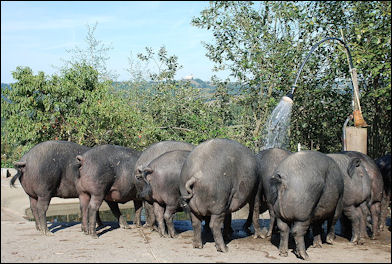
Unlike other domesticated animals, pigs are prized as sources of meat and little else. They can't be ridden, milked or used to pull or carry things but they are the most efficient meat producer known to man.
Wild boars and domesticated pigs are the same species. They can interbreed and produce viable offspring. Physically, domesticated pigs are fatter and have a shorter snout than their cousins. However, feral pigs that descended from escaped domesticated pigs develop long snouts and sleek bodies like wild boars.
Hogs is the term used by scientists and people in the livestock industry to describe the family of animals that includes pigs and boars. The term pig is used to describe a young hog. In the livestock industry, few hogs live to old age and most are technically pigs when they are slaughtered. A male hog is called a boar. A female is called a sow. Young are called piglets. A group is called a flock. A group used to be called a sloth.
Hogs belong to the large group of even-toed hoofed animals known as Artiodactyls. They are more closely related to hippopotamuses than cattle or sheep. Some hogs get to be quite large. According to the Guinness Book of Records, the world's largest pig weighed 1158 kilograms (2,552 pounds).
Book: “The Complete Pig: An Entertaining History of Pigs” by Sara Rath (Voyageur, 2000)
See Separate Article WILD BOARS factsanddetails.com
History and Domestication of Pigs
Pigs are believed to have been domesticated from boars 10,000 years ago in Turkey, a Muslim country that ironically frowns upon pork eating today. At a 10,000-year-old Turkish archeological site known as Hallan Cemi, scientists looking for evidence of early agriculture stumbled across of large cache of pig bones instead. The archaeologists reasoned the bones came from domesticated pigs, not wild ones, because most of the bones belonged to males over a year old. The females, they believe, were saved so they could produce more pigs.

Catalhouk, Turkey, world's oldest
village, near where pig bones were found Pigs were originally tuber-eating forest and swamp creatures. They had difficulty living in the deserts of the Middle East because they don't sweat and therefore can't cool themselves. When pigs were first domesticated there were vast forest areas in what is now Turkey and the Middle East. There was enough water and shade to support small number of pigs, but as population in the Middle East grew, deforestation degraded the environments best suited for the animals.
Pigs were first cloned in 2000, opening the way for the cloning of animals to produce organs, possible for human transplants. Today, Pigs are being cloned and genetically modified with a gene from the nematode worm that gives their meat up to five times the normal levels of omega 3 fatty acids, usually found in fish and vegetable oils. One of the benefits of this technology is that it reduces the need to eat fish to get Omega 3s.
Pig Characteristics
Hogs have a unique flexible muzzle. "The nostrils open on a tough, movable, disklike plate. The inside of the snout is firmly attached to the skull by means of gristle. Primitive hog types living in the wild use the snout to lift, shove, dig and break through brush in search of food."
Hogs have four toes. The second and third are functional; the first and forth are situated on either sides of the foot and serve no real purpose. Pigs don't sweat and therefore can't cool themselves. They wallow in the mud to keep cool. This practice of wallowing, sometimes in their own feces, has given them the bum rap of being dirty, filthy animals.
All species of pig have pair of teeth on either side of their head that have been turned into tusks. They are usually bigger among males than females. Males use them to fight. Pig molars are low-crowned like those of man. Their internal organs are also similar to those of humans. Scientists are working on adapting pig organs so they can be used in transplants with humans.
Pig saliva contains pheremones such as S-alphandrosterol that communicate sexual desires. Male pigs and truffles release this steroid. Females will go to great lengths to get a whiff of the stuff which is why female pigs are such good truffle hunters.
Pigs are very smart. They are often ranked higher than dogs on intelligence lists. They make affectionate pets and have been taught to do a variety of tricks. They are also relatively independent. Pigs are difficult to herd over long distances.
Pig Feeding and Mating Behavior
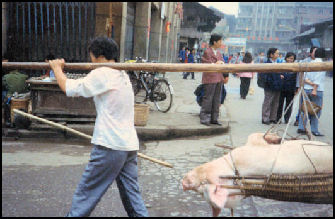
Hogs are not cud-chewing ruminants like sheep, cattle and goats and antelope, which have four-chambered stomachs. Pigs and other members of “swidae” family have single stomachs that can take in and digest all kinds of food.
Pigs traditionally fed mostly on acorns on the forest floor and roots, seeds, and acorns they rooted in the soil. They can eat grass but can not subsist off of it alone like sheep, horses and cattle. On farms pigs have traditionally been fed corn, clover, soybeans, and alfalfa but these days are given special hog feeds that contain vitamins and minerals and often antibiotics and hormones. Hogs will eat almost anything. One ate my shit after I did my business in a field in a hill tribe village in Laos. Families living near lakes collect water hyacinth and use it for pig feed.
Pigs can also multiple very quickly. Sows reach sexual maturity at age one and can produce two litters a year. The litters average eight piglets and are produced after a four month gestation period. In contrast cows become sexually mature after two years and generally only bear one calf after a nine month gestation period. According to the Guinness Book of Records, the world's largest pig litter contained 37 piglets.
Pigs as Food
Pigs are by far the most efficient protein- and fat-producing animal domesticated by man. Almost 35 percent of the food by weight fed to pig is converted to meat, compared to 13 percent for sheep, 14 percent for chicken and 6.5 percent for cattle. In the United States and Europe the most common pig breeds are the Duroc-Jersey, the black Poland China, the spotted Poland China, the Chester white, Tamworth, White Yorkshire, and Berkshire.
Large litters of piglets grow fast into meat producers. The piglets can be fattened up to a 400 pound hog in six months. Pigs are slaughtered when they are four to ten months of age, when they weigh 175 to 225 pounds. Beyond this weight it becomes more expensive to feed them for the amount of meat they produce.
Hogs produce pork, hams, bacon, sausages, and lard. Pork is contains high-grade fats and proteins. Lard is rarely used for cooking anymore. It has largely been replaced by vegetable oils but is widely used in processed food. Hog tissue is used in some medicines; hog fat finds it way into some industrial chemicals. Hog hair is made into bristles for brushes. Blood is sometimes used to make fertilizer.
Muslims and Pork
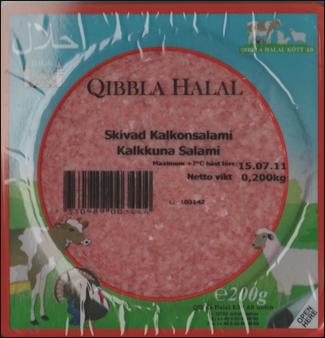
Halal sliced turkey salami Muslims and Jews (and some Christians) are forbidden from eating pork. The Jewish and Christian God spoke out twice against eating pork in the Old Testament (in Genesis and again in Leviticus), denouncing the pig as an unclean animal that "pollutes if it is tasted or touched." Allah delivered essentially the same message to Mohammed in the 7th century, but revoked the Biblical taboo on eating camel flesh.
Pork is the only food that the Koran specifically forbids Moslems to eat. The Koran states: "Forbidden to you (as food) are carrion and blood and swine-flesh.” By contrast Jews are forbidden by the Bible from the eating of birds, four-footed beats with "paws" (wildcats, lions, foxes, wolves, dogs and cats), water dwellers with scales or fins (eels, shellfish, whales, dolphins, sturgeons, lampreys, and catfish), "all winged insects that go upon all fours" (with the exception of locusts, crickets and grasshoppers "which leap upon the earth"), "camel, rock badger and hare" and animals that "chew the cud" but are not "cloven footed" (pigs).
Muslims are supposed to watch out for alcohol and gelatin made from pork fat in their food with the same vigilance of vegetarians who scan packaging labels for signs of lard. Vanilla, wine vinegar, cider and perfume are supposed to be avoided because they all contain alcohol. Gelatine made from pork fat is found in marshmallows, cream pies, cake fillings, candies and commercial yoghurt. Some devout Muslims scrap the icing off of cupcakes and cake lest the be contaminated with lard.
Eating pork is for the most part forbidden but if you are crossing the desert and no other food is available it is alright to eat it.
History of Muslims and Pork
In the fifth and forth millennia B.C. in Mesopotamia, 30 percent of bones excavated in Tell Asmar (2800-2700 BC) belonged to pigs. Pork was eaten in Ur in pre-Dynastic times. After 2400 B.C. it had become taboo. In Egypt, pigs were eaten, but there was prejudice against pork associated with Seti, the God of Evil.
In an attempt to explain why pork was forbidden, the 12th century Jewish-Muslim physician Maimonides wrote pig flesh "has a bad and damaging effect upon the body." But he didn't offer any specifics. In the 19th century, the discovery that trichinosis was caused from eating undercooked pork was offered as evidence to back up Maimonides assertion.
Why Is Pork Forbidden?
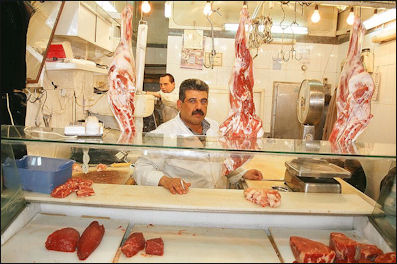
Muslim Halal butcher in Jerusalem Pigs are by far the most efficient protein and fat producing animal domesticated by man. They converts grains and tubers into high-grade fats and proteins more effectively than other animals. Almost 25 percent of the food by weight fed to pig is converted to meat, compared to 14 percent for chicken, 13 percent for sheep and 6.5 percent for cattle. In addition females produce litters that average eight piglets after a four gestation period. The piglets in turn can be fattened up to a 400 pound hog in six months.
Why is pork forbidden then? Scholars have generally argued that pork was forbidden because pigs have traditionally been regarded as dirty animals because they eat excrement and wallow in mud produced from their own urine and are associated with trichinosis, a disease is caused by the quarter-inch-long trichina worm, a kind of roundworm which digs into the muscles and produces cysts that can be fatal.
Columbia anthropologist Marvin Harris has said something else must be involved. "Hungry cows will eat human excrement with gusto," he wrote. "Dogs and chickens do the same thing without getting anyone very upset...The pig is a vector of human disease, but so are other domestic animals freely consumed by Moslems and Jews. For example, undercooked beef is a source of parasites, notably tapeworms, which can reach a length of sixteen to twenty feet within a man's intestines." Cattle, sheep and goats are sources of anthrax, brucellosis and other human diseases.
Pork Taboo and the Environment
Harris offers a natural and environmental explanation for the prohibition of pork. Pigs, he argued, were originally primarily tubor-eating forest and swamp creatures that had difficulty living in the deserts of the Middle East because they don't sweat and therefore can't cool themselves. Their habit of rolling around in urine and excrement is a way to keep cool. Pigs also have difficulty living in arid regions because they can not subsist off of grass alone, they are difficult to herd over long distances, and they don't produce milk.
When pigs were first domesticated there were vast forest areas in what is now Turkey and the Middle East. Ten thousand years ago, Harris argues, there was enough water and shade to support small number of pigs, but as the population in the Middle East grew, deforestation degraded the environments best suited for pigs. As a result pigs became a luxury that most people couldn't afford, their dirty behavior increased in the hot conditions and the taboo against the animal developed.
Unlike other domesticated animals, pigs are prized as source of meat and little else. They can't be ridden, milked or used to pull or carry things.
Industrial Pig Farms
Industrial pig farms can be horrid places. The pigs are raised using the “vertical integration” method in which they are packed inside metal-roof barns so close together they can hardily move. The pigs do little more than eat and grow before being slaughtered after a few months. Their excrement drops through slats on the floor and is flushed through pipes to huge football field-field-size collection areas called lagoons. The stink can be awful, especially for people living downwind from the facility. Even though efforts are made to line the lagoons with impermeable materials, excrement can still seep into the groundwater. Sometimes dead pigs collected for incineration attract wild dogs. Some public health officials think the “swine flu” outbreak in 2010 originated in a Mexican industrial pig farm.
Industrially-raised hogs are treated horribly. Piglets are weaned from the mothers at 10 days as opposed to 13 weeks in nature. They are quickly fattened up with hormone- and antibiotic-laced feed and never let out doors. Their premature weaning leaves them with a lifelong desire to suck and chew. In confinement this desire is often manifested in the sucking and chewing of the tails of other pigs that are made so moribund by their treatment they don’t fight back. Often times the tail stubs become infected. Sick pigs are clubbed to death on the spot.
In their pens pigs are prevented from rooting — their most basic instinct after sex and their usual means they get food. Males pigs are castrated without anesthesia.
Environmental Problems Created by Pigs
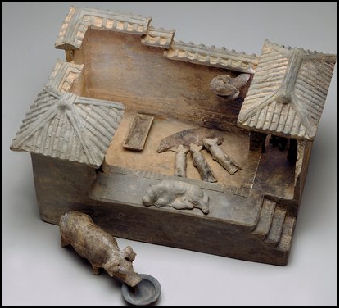
5th century Han Dynasty China pig sty latrine
Industrial CAFO — concentrated animal feeding operations—“generates as much sewage as a mid-size city.” Farm-raised pigs produces large amounts of phosphorous in their feces. This phosphorous runs off into lakes, rivers and estuaries when it rains — depleting oxygen supplies, killing fish, stimulating algae growth and generating greenhouse gases. In the 1980s, pigs farms were blamed for phosphorous pollution that killed all the aquatic life in Denmark’s 42-kilometer-long Mariager Fjord.
Bioengineering has created an “Enviropig” that produces manure with virtually no phosphorus. These pigs have a DNA molecule transplanted into them when they are embryos that gives them the ability to draw phosphorous from foods with an enzyme in their saliva, negating the need for phosphorus supplements that end up in the manure, and reducing the phosphorus content of the manure by up to 75 percent . Bioengineering also has produced pigs that can feed on grasses and hay like cows, negating the need for grains as pig feed.
In the Netherlands, researchers have created pig farms that collect waste and use it to generate electricity to run the farm and have enough electricity left over ro provide power to sell to the national grid. One research farm run by Wageningen University generates enough electricity to power 1,500 homes. The pigs have been trained to deposit their wastes in an area with a slated floor at the middle of the barn while spending most of their time in open stalls on the side. The slurry is channeled into three 4,000 cubic-meter tanks, where other organic wastes like low-quality grain are sent. Carrot juice is added to boost methane output. The only problem is expense. The farm described above costs about $1.3 million.
World’s Top Pig Exporting and Importing Countries
World’s Top Exporters of Pigs (2020): 1) Denmark: 15893660 head; 2) Netherlands: 10545631 head; 3) Canada: 5310689 head; 4) Thailand: 3173497 head; 5) Germany: 2180304 head; 6) China: 1380891 head; 7) Spain: 1360227 head; 8) Belgium: 973697 head; 9) France: 827529 head; 10) Slovakia: 587331 head; 11) Portugal: 549591 head; 12) Hungary: 460618 head; 13) Netherlands: 432702 tonnes; 14) Denmark: 429850 tonnes; 15) Czechia: 413249 head; 16) Indonesia: 409389 head; 17) Croatia: 388788 head; 18) Latvia: 230476 head; 19) Thailand: 215157 tonnes; 20) Lithuania: 132137 head: [Source: FAOSTAT, Food and Agriculture Organization (U.N.), fao.org]
World’s Top Exporters (in value terms) of Pigs (2020): 1) Denmark: US$1295117,000; 2) Netherlands: US$907879,000; 3) China: US$521233,000; 4) Thailand: US$510949,000; 5) Canada: US$288378,000; 6) Germany: US$207627,000; 7) France: US$170638,000; 8) Spain: US$157637,000; 9) Belgium: US$148312,000; 10) Indonesia: US$75490,000; 11) Portugal: US$74645,000; 12) Slovakia: US$64705,000; 13) Czechia: US$64678,000; 14) Hungary: US$59283,000; 15) Croatia: US$58565,000; 16) Malaysia: US$25200,000; 17) United States: US$22519,000; 18) Ireland: US$19378,000; 19) Latvia: US$19210,000; 20) Lithuania: US$17323,000

Yunnan pigstyWorld’s Top Importers of Pigs (2020): 1) Germany: 12389432 head; 2) Poland: 7027838 head; 3) Spain: 2620409 head; 4) United States: 2374478 head; 5) Cambodia: 1935133 head; 6) Netherlands: 1471069 head; 7) Hungary: 1181521 head; 8) Romania: 1147421 head; 9) Portugal: 1018000 head; 10) Italy: 1017404 head; 11) Belgium: 990516 head; 12) Hong Kong: 643450 head; 13) United Kingdom: 595843 head; 14) Croatia: 555779 head; 15) Singapore: 541490 head; 16) Germany: 534633 tonnes; 17) Austria: 459024 head; 18) Laos: 367210 head; 19) Slovakia: 270135 head; 20) Poland: 221258 tonnes [Source: FAOSTAT, Food and Agriculture Organization (U.N.), fao.org]
World’s Top Importers (in value terms) of Pigs (2020): 1) Germany: US$1105070,000; 2) Poland: US$538379,000; 3) Cambodia: US$350387,000; 4) Hong Kong: US$329272,000; 5) United States: US$261961,000; 6) Spain: US$250037,000; 7) Vietnam: US$152908,000; 8) Portugal: US$147264,000; 9) Netherlands: US$144625,000; 10) Hungary: US$139232,000; 11) Italy: US$128486,000; 12) Romania: US$121272,000; 13) Singapore: US$119800,000; 14) Belgium: US$103545,000; 15) United Kingdom: US$90268,000; 16) Austria: US$72310,000; 17) China: US$66516,000; 18) Laos: US$56180,000; 19) Slovakia: US$45913,000; 20) Macao: US$45426,000
World’s Top Pig Meat Producing and Exporting Countries
World’s Top Producers of Pig Meat (2020): 1) China: 41133300 tonnes; 2) United States: 12845097 tonnes; 3) Germany: 5118000 tonnes; 4) Spain: 5003430 tonnes; 5) Brazil: 4482048 tonnes; 6) Russia: 4281613 tonnes; 7) Vietnam: 3550105 tonnes; 8) Canada: 2299446 tonnes; 9) France: 2201110 tonnes; 10) Poland: 1985120 tonnes; 11) Netherlands: 1661650 tonnes; 12) Mexico: 1652362 tonnes; 13) Denmark: 1595630 tonnes; 14) Philippines: 1499853 tonnes; 15) South Korea: 1403000 tonnes; 16) Japan: 1305792 tonnes; 17) Italy: 1286690 tonnes; 18) Myanmar: 1127135 tonnes; 19) Belgium: 1098800 tonnes; 20) United Kingdom: 984000 tonnes [Source: FAOSTAT, Food and Agriculture Organization (U.N.), fao.org. A tonne (or metric ton) is a metric unit of mass equivalent to 1,000 kilograms (kgs) or 2,204.6 pounds (lbs). A ton is an imperial unit of mass equivalent to 1,016.047 kg or 2,240 lbs.]
World’s Top Exporters of Pig Meat (2020): 1) Spain: 1274115 tonnes; 2) Germany: 952473 tonnes; 3) United States: 848837 tonnes; 4) Netherlands: 798115 tonnes; 5) Denmark: 730728 tonnes; 6) Belgium: 633514 tonnes; 7) France: 400537 tonnes; 8) Canada: 248873 tonnes; 9) Poland: 238743 tonnes; 10) United Kingdom: 225047 tonnes; 11) Chile: 210127 tonnes; 12) Ireland: 130007 tonnes; 13) Russia: 91541 tonnes; 14) Hungary: 79094 tonnes; 15) Italy: 76813 tonnes; 16) Austria: 58969 tonnes; 17) Portugal: 40237 tonnes; 18) Brazil: 31218 tonnes; 19) Finland: 26200 tonnes; 20) Slovakia: 20106 tonnes
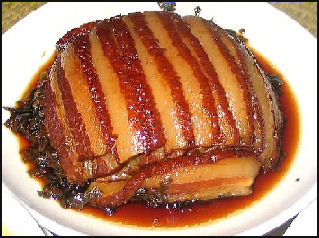
pork dish in China
World’s Top Exporters (in value terms) of Pig Meat (2020): 1) Spain: US$3826008,000; 2) Germany: US$2468085,000; 3) Netherlands: US$2163397,000; 4) Denmark: US$1732692,000; 5) United States: US$1591201,000; 6) Belgium: US$1271921,000; 7) France: US$934865,000; 8) Chile: US$614589,000; 9) Canada: US$543945,000; 10) Poland: US$477168,000; 11) United Kingdom: US$454436,000; 12) Ireland: US$367347,000; 13) Hungary: US$193810,000; 14) Italy: US$188240,000; 15) Russia: US$177315,000; 16) Austria: US$155753,000; 17) Portugal: US$106722,000; 18) China: US$71951,000; 19) Finland: US$67822,000; 20) Australia: US$59316,000
Top Producing Countries of Pig Meat in 2008 (Production, $1000; Production, metric tons, FAO): 1) China, 47774428 , 47177631; 2) United States of America, 9638402 , 9518000; 3) Germany, 4516303 , 4459886; 4) Spain, 3575649 , 3469198; 5) Brazil, 3053255 , 3015114; 6) Canada, 2874331 , 2838425; 7) Vietnam, 2501407 , 2470159; 8) France, 2258209 , 2230000; 9) Denmark, 2078970 , 2053000; 10) Netherlands, 2045284 , 2019735; 11) Russian Federation, 2034451 , 2009037; 12) Poland, 1947123 , 1922800; 13) Philippines, 1627112 , 1606786; 14) Italy, 1576696 , 1557000; 15) Japan, 1264193 , 1248401; 16) Mexico, 1164318 , 1149774; 17) Republic of Korea, 1069455 , 1056096; 18) Belgium, 1017115 , 1004410; 19) Thailand, 826098 , 815779; 20) United Kingdom, 700753 , 692000.
World’s Top Pig Meat Importing Countries
World’s Top Importers of Pig Meat (2020): 1) China: 3246913 tonnes; 2) Italy: 726749 tonnes; 3) Germany: 673903 tonnes; 4) Poland: 480919 tonnes; 5) Mexico: 377316 tonnes; 6) Hong Kong: 205461 tonnes; 7) United Kingdom: 204646 tonnes; 8) Netherlands: 200000 tonnes; 9) Romania: 130081 tonnes; 10) Czechia: 128205 tonnes; 11) Greece: 113368 tonnes; 12) Chile: 101836 tonnes; 13) Slovakia: 99750 tonnes; 14) France: 92954 tonnes; 15) Bulgaria: 72614 tonnes; 16) Spain: 70064 tonnes; 17) Portugal: 69434 tonnes; 18) Austria: 68659 tonnes; 19) United States: 56494 tonnes; 20) Hungary: 54064 tonnes [Source: FAOSTAT, Food and Agriculture Organization (U.N.), fao.org]
World’s Top Importers (in value terms) of Pig Meat (2020): 1) China: US$9395456,000; 2) Italy: US$1592229,000; 3) Germany: US$1301431,000; 4) Poland: US$1043647,000; 5) Hong Kong: US$645049,000; 6) Mexico: US$612940,000; 7) United Kingdom: US$572063,000; 8) Netherlands: US$517863,000; 9) France: US$303940,000; 10) Czechia: US$301214,000; 11) Romania: US$297760,000; 12) Greece: US$292525,000; 13) Chile: US$265099,000; 14) Slovakia: US$244022,000; 15) Portugal: US$232680,000; 16) Austria: US$176896,000; 17) United States: US$155569,000; 18) Belgium: US$152751,000; 19) Spain: US$151202,000; 20) Bulgaria: US$149324,000
World’s Top Pork Exporting and Importing Countries
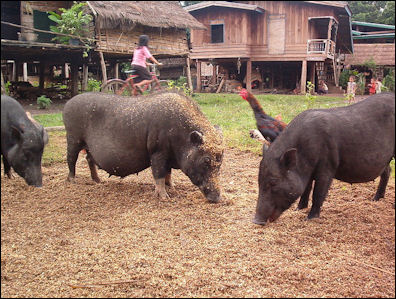
Pigs in Laotian villageWorld’s Top Exporters of Pork (2020): 1) United States: 1503159 tonnes; 2) Canada: 940986 tonnes; 3) Brazil: 869882 tonnes; 4) Spain: 858574 tonnes; 5) Germany: 804371 tonnes; 6) Denmark: 378161 tonnes; 7) Netherlands: 247947 tonnes; 8) Mexico: 233010 tonnes; 9) Poland: 152503 tonnes; 10) Austria: 79035 tonnes; 11) France: 73368 tonnes; 12) Hungary: 68787 tonnes; 13) Belgium: 64233 tonnes; 14) Ireland: 50880 tonnes; 15) Russia: 38040 tonnes; 16) United Kingdom: 34545 tonnes; 17) Chile: 22109 tonnes; 18) Thailand: 21920 tonnes; 19) Czechia: 15068 tonnes; 20) Australia: 13605 tonnes [Source: FAOSTAT, Food and Agriculture Organization (U.N.), fao.org]
World’s Top Exporters (in value terms) of Pork (2020): 1) United States: US$4394795,000; 2) Spain: US$2621946,000; 3) Canada: US$2619853,000; 4) Germany: US$2363078,000; 5) Brazil: US$2073345,000; 6) Denmark: US$1387950,000; 7) Mexico: US$858971,000; 8) Netherlands: US$767192,000; 9) Poland: US$404186,000; 10) Austria: US$271770,000; 11) France: US$227904,000; 12) Belgium: US$187464,000; 13) Hungary: US$185828,000; 14) Ireland: US$172165,000; 15) Chile: US$109238,000; 16) Thailand: US$92652,000; 17) United Kingdom: US$87969,000; 18) Russia: US$87744,000; 19) Finland: US$44629,000; 20) Czechia: US$43754,000
World’s Top Importers of Pork (2020): 1) China: 1056640 tonnes; 2) Japan: 889309 tonnes; 3) South Korea: 417766 tonnes; 4) Mexico: 325316 tonnes; 5) United States: 260320 tonnes; 6) United Kingdom: 183615 tonnes; 7) Poland: 175413 tonnes; 8) Italy: 165172 tonnes; 9) France: 163879 tonnes; 10) Canada: 154172 tonnes; 11) Australia: 146977 tonnes; 12) Romania: 142728 tonnes; 13) Czechia: 142123 tonnes; 14) Vietnam: 117825 tonnes; 15) Germany: 112072 tonnes; 16) Singapore: 83860 tonnes; 17) Hungary: 69934 tonnes; 18) Colombia: 63400 tonnes; 19) Netherlands: 62398 tonnes; 20) Bulgaria: 53789 tonnes [Source: FAOSTAT, Food and Agriculture Organization (U.N.), fao.org]
World’s Top Importers (in value terms) of Pork (2020): 1) Japan: US$4437399,000; 2) China: US$2485760,000; 3) South Korea: US$1382473,000; 4) United States: US$892718,000; 5) Mexico: US$693298,000; 6) United Kingdom: US$574109,000; 7) Canada: US$543102,000; 8) France: US$537377,000; 9) Australia: US$503602,000; 10) Italy: US$494059,000; 11) Poland: US$492548,000; 12) Czechia: US$412997,000; 13) Germany: US$386675,000; 14) Romania: US$377820,000; 15) Vietnam: US$316033,000; 16) Singapore: US$265378,000; 17) Hungary: US$187853,000; 18) Netherlands: US$181899,000; 19) Greece: US$169265,000; 20) Taiwan: US$157225,000
World’s Top Bacon and Ham Exporting and Importing Countries
World’s Top Exporters of Bacon and Ham (2020): 1) Netherlands: 105769 tonnes; 2) Italy: 71987 tonnes; 3) Spain: 67160 tonnes; 4) United States: 60066 tonnes; 5) Germany: 52328 tonnes; 6) Denmark: 41884 tonnes; 7) Canada: 34652 tonnes; 8) Poland: 27687 tonnes; 9) Belgium: 20695 tonnes; 10) United Kingdom: 13704 tonnes; 11) Ireland: 10904 tonnes; 12) Austria: 7767 tonnes; 13) France: 6820 tonnes; 14) Portugal: 2544 tonnes; 15) Croatia: 2100 tonnes; 16) Hungary: 1659 tonnes; 17) Montenegro: 1115 tonnes; 18) Czechia: 779 tonnes; 19) Slovenia: 693 tonnes; 20) Bulgaria: 665 tonnes [Source: FAOSTAT, Food and Agriculture Organization (U.N.), fao.org]
World’s Top Exporters (in value terms) of Bacon and Ham (2020): 1) Italy: US$972866,000; 2) Spain: US$602813,000; 3) Netherlands: US$381010,000; 4) Germany: US$328836,000; 5) United States: US$236557,000; 6) Denmark: US$146430,000; 7) Canada: US$139054,000; 8) Belgium: US$116558,000; 9) Poland: US$91385,000; 10) Austria: US$78870,000; 11) United Kingdom: US$64147,000; 12) France: US$55766,000; 13) Ireland: US$50172,000; 14) Croatia: US$16655,000; 15) Portugal: US$14038,000; 16) Hungary: US$9842,000; 17) Montenegro: US$9171,000; 18) Slovenia: US$5224,000; 19) Sweden: US$5152,000; 20) Switzerland: US$3741,000
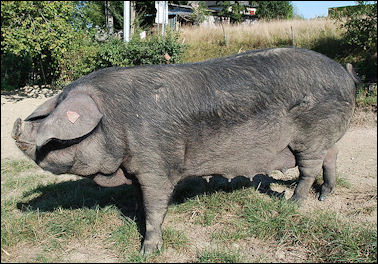
World’s Top Importers of Bacon and Ham (2020): 1) United Kingdom: 170915 tonnes; 2) France: 42200 tonnes; 3) United States: 34105 tonnes; 4) Germany: 25659 tonnes; 5) Canada: 25438 tonnes; 6) Denmark: 20195 tonnes; 7) Italy: 18685 tonnes; 8) Belgium: 17408 tonnes; 9) Ireland: 16616 tonnes; 10) Mexico: 12065 tonnes; 11) Netherlands: 10948 tonnes; 12) Portugal: 8842 tonnes; 13) Austria: 7182 tonnes; 14) Spain: 6323 tonnes; 15) Czechia: 4888 tonnes; 16) Romania: 4739 tonnes; 17) Panama: 4550 tonnes; 18) Sweden: 4427 tonnes; 19) Poland: 4136 tonnes; 20) Japan: 3279 tonnes [Source: FAOSTAT, Food and Agriculture Organization (U.N.), fao.org]
World’s Top Importers (in value terms) of Bacon and Ham (2020): 1) United Kingdom: US$674513,000; 2) France: US$380041,000; 3) Germany: US$278419,000; 4) United States: US$265277,000; 5) Belgium: US$153086,000; 6) Canada: US$149867,000; 7) Italy: US$112246,000; 8) Denmark: US$106003,000; 9) Netherlands: US$95426,000; 10) Ireland: US$66413,000; 11) Austria: US$62728,000; 12) Mexico: US$61957,000; 13) Portugal: US$57935,000; 14) Switzerland: US$50086,000; 15) Sweden: US$43327,000; 16) Japan: US$43112,000; 17) Poland: US$38389,000; 18) Czechia: US$31705,000; 19) Australia: US$27666,000; 20) Romania: US$26316,000. [Source: FAOSTAT, Food and Agriculture Organization (U.N.), fao.org]
World’s Top Pig Meat Sausage Exporting and Importing Countries
World’s Top Exporters of Pig Meat Sausages (2020): 1) Germany: 158825 tonnes; 2) United States: 153185 tonnes; 3) Brazil: 115023 tonnes; 4) Spain: 77251 tonnes; 5) Italy: 75586 tonnes; 6) Netherlands: 72742 tonnes; 7) Belgium: 60541 tonnes; 8) Austria: 54447 tonnes; 9) France: 46129 tonnes; 10) Russia: 44472 tonnes; 11) Denmark: 34217 tonnes; 12) Belarus: 33658 tonnes; 13) Slovakia: 30316 tonnes; 14) Czechia: 26543 tonnes; 15) China: 24559 tonnes; 16) Turkey: 21208 tonnes; 17) Hungary: 19899 tonnes; 18) Romania: 17583 tonnes; 19) Ireland: 17304 tonnes; 20) Portugal: 15777 tonnes [Source: FAOSTAT, Food and Agriculture Organization (U.N.), fao.org]

World’s Top Exporters (in value terms) of Pig Meat Sausages (2020): 1) Germany: US$859542,000; 2) Italy: US$629498,000; 3) United States: US$580008,000; 4) Spain: US$542608,000; 5) Austria: US$348017,000; 6) France: US$243389,000; 7) Netherlands: US$219128,000; 8) Belgium: US$187255,000; 9) Denmark: US$176472,000; 10) Hungary: US$124652,000; 11) Brazil: US$115569,000; 12) Czechia: US$97545,000; 13) Belarus: US$93848,000; 14) Russia: US$92816,000; 15) Slovakia: US$90404,000; 16) Romania: US$88123,000; 17) China: US$84637,000; 18) Ireland: US$73563,000; 19) Portugal: US$46696,000; 20) Canada: US$42685,000
World’s Top Importers of Pig Meat Sausages (2020): 1) United Kingdom: 135932 tonnes; 2) Germany: 103715 tonnes; 3) France: 72298 tonnes; 4) Netherlands: 54141 tonnes; 5) Belgium: 51871 tonnes; 6) Hungary: 44603 tonnes; 7) Slovakia: 40470 tonnes; 8) Kazakhstan: 38405 tonnes; 9) Angola: 38270 tonnes; 10) Mexico: 37466 tonnes; 11) Denmark: 31261 tonnes; 12) Japan: 29505 tonnes; 13) Russia: 28138 tonnes; 14) Canada: 25948 tonnes; 15) Spain: 23553 tonnes; 16) Czechia: 21872 tonnes; 17) Hong Kong: 19440 tonnes; 18) Romania: 18520 tonnes; 19) Serbia: 15657 tonnes; 20) Sweden: 15388 tonnes [Source: FAOSTAT, Food and Agriculture Organization (U.N.), fao.org]
World’s Top Importers (in value terms) of Pig Meat Sausages (2020): 1) Germany: US$708477,000; 2) United Kingdom: US$681132,000; 3) France: US$380280,000; 4) Belgium: US$263228,000; 5) Netherlands: US$237831,000; 6) Mexico: US$166138,000; 7) Japan: US$160193,000; 8) Slovakia: US$139141,000; 9) Hungary: US$138831,000; 10) Denmark: US$121243,000; 11) Canada: US$111681,000; 12) Spain: US$104931,000; 13) Sweden: US$99160,000; 14) Czechia: US$94856,000; 15) Austria: US$94072,000; 16) Switzerland: US$80500,000; 17) Russia: US$79046,000; 18) Kazakhstan: US$78981,000; 19) Hong Kong: US$77300,000; 20) Romania: US$72902,000
World’s Top Pig Fat Producing and Exporting Countries
World’s Top Producers of Pig Fat (2020): 1) United States: 3437420 tonnes; 2) China: 2413154 tonnes; 3) Brazil: 531443 tonnes; 4) Russia: 287319 tonnes; 5) Philippines: 205694 tonnes; 6) Vietnam: 204400 tonnes; 7) Canada: 185077 tonnes; 8) Japan: 157074 tonnes; 9) Argentina: 116144 tonnes; 10) Mexico: 115880 tonnes; 11) South Korea: 94797 tonnes; 12) Myanmar: 82878 tonnes; 13) United Kingdom: 62147 tonnes; 14) Taiwan: 60776 tonnes; 15) Ukraine: 42978 tonnes; 16) Thailand: 36258 tonnes; 17) Belarus: 28613 tonnes; 18) Ecuador: 27138 tonnes; 19) Colombia: 26737 tonnes; 20) Indonesia: 26549 tonnes [Source: FAOSTAT, Food and Agriculture Organization (U.N.), fao.org]
World’s Top Exporters of Pig Fat (2020): 1) Germany: 152640 tonnes; 2) Spain: 148006 tonnes; 3) Poland: 66547 tonnes; 4) Netherlands: 59263 tonnes; 5) United States: 53871 tonnes; 6) Canada: 52679 tonnes; 7) Italy: 48656 tonnes; 8) France: 29381 tonnes; 9) Chile: 26597 tonnes; 10) Denmark: 21680 tonnes; 11) Belgium: 20789 tonnes; 12) Austria: 12507 tonnes; 13) Russia: 8574 tonnes; 14) Hungary: 8469 tonnes; 15) Ireland: 6557 tonnes; 16) Sweden: 5982 tonnes; 17) Lithuania: 5863 tonnes; 18) United Kingdom: 2617 tonnes; 19) Portugal: 2182 tonnes; 20) Finland: 1908 tonnes
World’s Top Exporters (in value terms) of Pig Fat (2020): 1) Spain: US$208589,000; 2) Germany: US$131268,000; 3) Canada: US$86085,000; 4) Netherlands: US$72909,000; 5) Italy: US$57950,000; 6) Poland: US$53247,000; 7) United States: US$42720,000; 8) Chile: US$38404,000; 9) France: US$35521,000; 10) Denmark: US$30871,000; 11) Belgium: US$23216,000; 12) Austria: US$10476,000; 13) Russia: US$10244,000; 14) Ireland: US$8707,000; 15) Hungary: US$8112,000; 16) Lithuania: US$7923,000; 17) Sweden: US$5628,000; 18) United Kingdom: US$2397,000; 19) Finland: US$2383,000; 20) Brazil: US$1722,000
Image Sources: Wikimedia Commons
Text Sources: New York Times, Washington Post, Los Angeles Times, Times of London, Yomiuri Shimbun, The Guardian, National Geographic, The New Yorker, Time, Newsweek, Reuters, AP, Lonely Planet Guides, Compton’s Encyclopedia and various books and other publications.
Last updated April 2022
